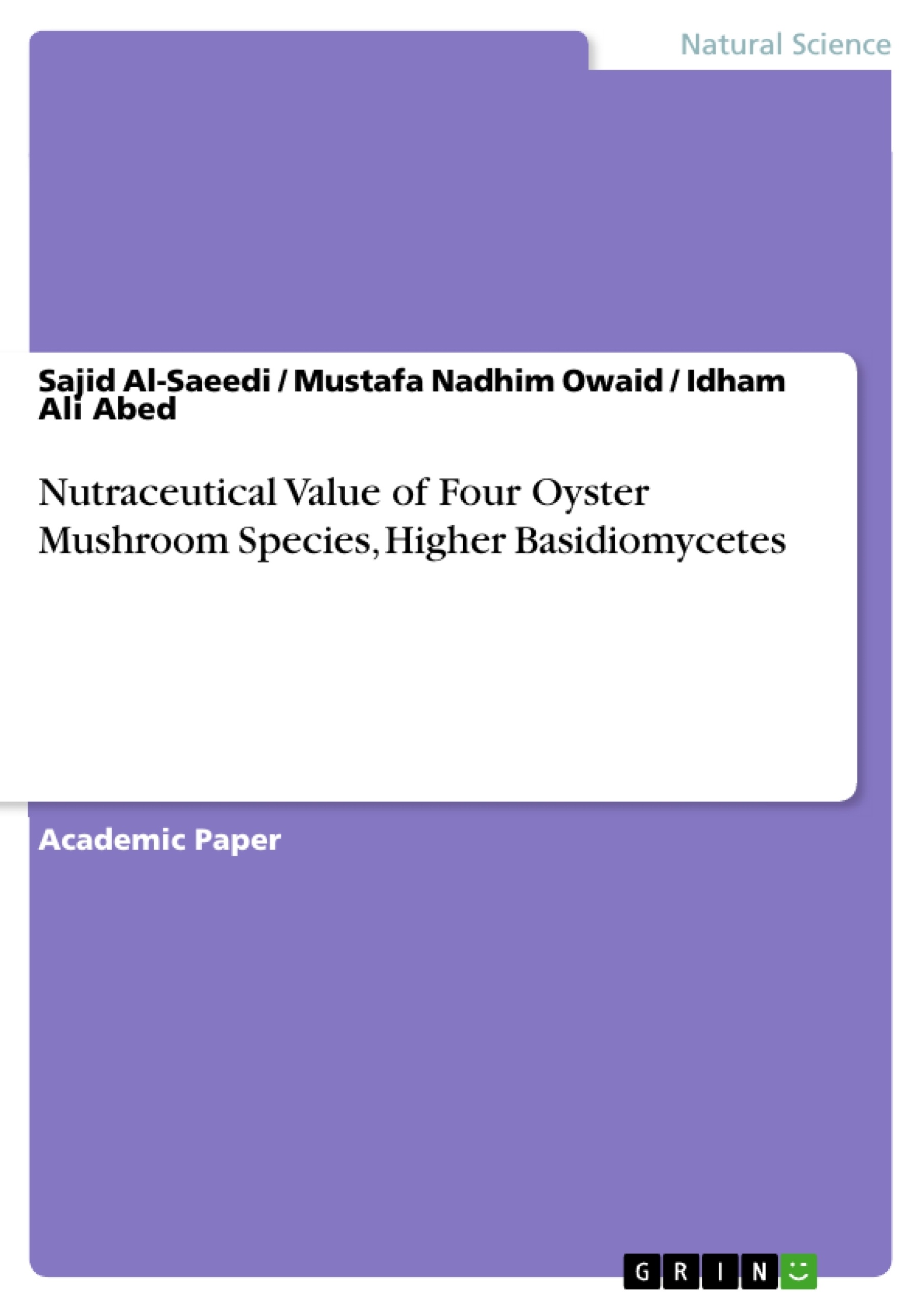This work was achieved to determine the nutritional value (total protein, crude fiber, phenolic compounds, total carbohydrate, ash, dry matter, moisture content and pH) of four oyster mushrooms species namely; P. ostreatus (grey), P. ostreatus (white), P. cornucopiae var. citrinopileatus (yellow) and P. salmoneostramineus (pink), were investigated on three agro-substrates mixtures; S1 (wheat straw), S2 (70% wheat straw, 20% sawdust and 10% date palm fiber) and S3 (50% wheat straw, 30% sawdust and 20% date palm fiber) media. The variety of oyster mushroom showed significant (P<0.05) differences of nutritional value of oyster mushroom on various substrates. The mixture which composed from one substrate was poorer in mineral value than others which composed from more one. Generally, the higher protein content showed in P. cornucopiae (32.21%) compared with P. ostreatus (grey) (23.83%) as a lower value. P. ostreatus (grey) recorded total phenol, total carbohydrates and crude fibers 2.82 g/kg, 40.72% and 9.97%, while P. salmoneostramineus recorded 1.35 g/kg, 48.02% and 23.75% respectively. P. ostreatus (white) showed higher value of ash and dry matter (11.3% and 12.81%) than P. ostreatus (grey) and P. salmoneostramineus in values 7.0% and 9.93%, respectively.
Inhaltsverzeichnis (Table of Contents)
- ABSTRACT
- Key Words
- Öz
- Anahtar Kelimeler
- INTRODUCTION
- MATERIALS and METHODS
- Sampling
- Determinations
- Statistical Analysis
- RESULTS ad DISCUSSION
- Protein Content
- Total Phenol Content
- Content of Carbohydrates
- Ash Content
- Total Fibers Content
- Dry Matter and Moisture Content
- The pH of Fruit Extracts
- DISCUSSION
Zielsetzung und Themenschwerpunkte (Objectives and Key Themes)
This research investigates the nutritional value of four oyster mushroom species cultivated on three different agro-substrates: wheat straw, a combination of wheat straw, sawdust, and date palm fiber, and a mixture of wheat straw, sawdust, and date palm fiber. The study aims to determine the impact of these substrates on the protein, total phenol, carbohydrate, ash, and fiber content of the oyster mushroom fruiting bodies.
- Nutritional value of oyster mushrooms cultivated on various substrates
- Impact of different substrates on protein content
- Influence of substrates on total phenol, carbohydrate, ash, and fiber levels
- Comparison of nutritional content across different oyster mushroom species
- Potential benefits of utilizing date palm fiber in mushroom cultivation
Zusammenfassung der Kapitel (Chapter Summaries)
- ABSTRACT: The study examines the nutritional value of four oyster mushroom species (Pleurotus ostreatus (grey), P. ostreatus (white), P. cornucopiae var. citrinopileatus (yellow), and P. salmoneostramineus (pink)) grown on three different agro-substrates: wheat straw, a combination of wheat straw, sawdust, and date palm fiber, and a mixture of wheat straw, sawdust, and date palm fiber. The results show significant differences in nutritional value among the species and substrates.
- INTRODUCTION: The study introduces the importance of oyster mushrooms as a food source and discusses their medicinal properties and applications. The use of date palm residues as a substrate for oyster mushroom cultivation is highlighted as a cost-effective and sustainable alternative to commercial substrates like wheat straw.
- MATERIALS and METHODS: This section describes the sampling and experimental procedures used in the study, including the preparation of the agro-substrates, harvesting of the mushroom fruiting bodies, and the methods for determining protein, total phenol, carbohydrate, ash, fiber, dry matter, moisture content, and pH.
- RESULTS ad DISCUSSION: The results of the study are presented and analyzed, focusing on the protein, total phenol, carbohydrate, ash, and fiber content of the oyster mushrooms. The influence of the different substrates on these nutritional values is discussed, along with comparisons across the different oyster mushroom species. The potential benefits of using date palm fiber in mushroom cultivation are also addressed.
Schlüsselwörter (Keywords)
The study focuses on the nutritional value of four oyster mushroom species (Pleurotus spp.) cultivated on different agro-substrates, including wheat straw, sawdust, and date palm fiber. Key themes include protein content, total phenol, carbohydrate, ash, and fiber analysis, as well as the impact of substrate composition on mushroom nutritional value. The research highlights the potential benefits of utilizing date palm residues as a sustainable and cost-effective substrate for oyster mushroom cultivation.
- Quote paper
- Sajid Al-Saeedi (Author), Mustafa Nadhim Owaid (Author), Idham Ali Abed (Author), 2017, Nutraceutical Value of Four Oyster Mushroom Species, Higher Basidiomycetes, Munich, GRIN Verlag, https://www.grin.com/document/417171



